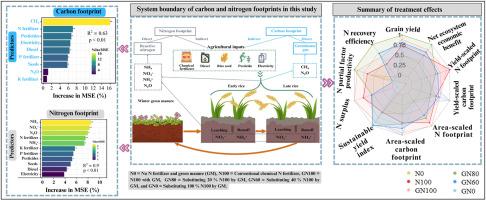绿肥替代减少了双稻系统的碳和氮足迹,提高了生态系统净经济效益
IF 10
1区 环境科学与生态学
Q1 ENGINEERING, ENVIRONMENTAL
引用次数: 0
摘要
可持续的水稻生产不仅需要高产,而且需要减少对环境的影响和改善经济效益。然而,可持续性评估往往忽略了碳足迹(CF)、氮足迹(NF)和净生态系统经济效益(NEEB)等关键指标。因此,本研究旨在综合评价绿肥(GM)替代化学氮肥(CNF)在提高双季稻生产效率、氮素利用效率和NEEB,同时降低CF和NF的长期效果。试验处理包括:无CNF (N0)、常规CNF (N100)、N100 + GM (GN100)、80% N100 + GM (GN80)、60% N100 + GM (GN60)和N0 + GM (GN0)。与N0、N100、GN100、GN60和GN0处理相比,以GM替代N100 (GN80)的20%,籽粒产量提高12.2% ~ 99.1%,收获指数提高3.4% ~ 20.8%,氮素恢复效率提高38.5% ~ 148.0%,NEEB提高19.0% ~ 129.0%。在GN80和GN60条件下,CF和NF呈显著正相关,而在GN100和GN100条件下呈权衡关系,表明转基因对CNF替代的减少可以同时缓解CF和NF。在本研究中,甲烷排放是CF的主要贡献者,而活性氮损失是NF的主要驱动因素。与GN100和GN0相比,GN80分别显著降低了24.1%和28.2%的年CF。与N100相比,它还大幅降低了年NF和产量比例NF,分别降低了17.3%和37.5%,与GN100相比,分别降低了27.7%和31.3%。此外,与GN0相比,GN80显著降低了年产量比例尺CF,降幅达22%,与GN0相比降幅高达50%。因此,我们建议用转基因替代20%的N100,在不牺牲产量或NEEB的情况下提高环境可持续性。这些发现拓宽了我们对转基因替代CNF如何影响CF和NF的理解,为促进可持续双季稻生产提供了新的见解。本文章由计算机程序翻译,如有差异,请以英文原文为准。


Green manure substitution reduces carbon and nitrogen footprints and improves net ecosystem economic benefits in double rice systems
Sustainable rice production requires not only high yields but also reduced environmental impacts and improved economic outcomes. However, sustainability assessments often overlook key indicators such as the carbon footprint (CF), nitrogen footprint (NF), and net ecosystem economic benefit (NEEB). This study, therefore, aims to comprehensively evaluate the long-term effectiveness of substituting green manure (GM) for chemical nitrogen fertilizer (CNF) in improving productivity, nitrogen use efficiency, and NEEB, while simultaneously reducing CF and NF in a double rice cropping system. The experimental treatments included: no CNF (N0), conventional CNF (N100), N100 plus GM (GN100), 80 %N100 plus GM (GN80), 60 %N100 plus GM (GN60), and N0 plus GM (GN0). Annually, substituting GM for 20 % of N100 (GN80) increased grain yield by 12.2 %–99.1 %, harvest index by 3.4 %–20.8 %, nitrogen recovery efficiency by 38.5 %–148.0 % and NEEB by 19.0 %–129.0 % compared with N0, N100, GN100, GN60, and GN0 treatments. The results also revealed a strong positive correlation between CF and NF under GN80 and GN60 but showed trade-off relationships under N100 and GN100, indicating that reduced CNF substitution by GM can simultaneously mitigate CF and NF. In this study, methane emissions were the primary contributors to CF, while reactive nitrogen losses were the main drivers of NF. Compared with GN100 and GN0, GN80 significantly reduced annual CF by 24.1 % and 28.2 %, respectively. It also substantially lowered annual NF and yield-scaled NF by 17.3 % and 37.5 % relative to N100, and by 27.7 % and 31.3 % relative to GN100. Furthermore, GN80 notably decreased annual yield-scaled CF by 22 % compared to N0 and by up to 50 % compared to GN0. Therefore, we recommend the GM substitution for 20 % of N100 to enhance environmental sustainability without sacrificing yield or NEEB. These findings broaden our understanding of how substituting GM for CNF influences CF and NF, offering new insights for promoting sustainable double rice production.
求助全文
通过发布文献求助,成功后即可免费获取论文全文。
去求助
来源期刊

Journal of Cleaner Production
环境科学-工程:环境
CiteScore
20.40
自引率
9.00%
发文量
4720
审稿时长
111 days
期刊介绍:
The Journal of Cleaner Production is an international, transdisciplinary journal that addresses and discusses theoretical and practical Cleaner Production, Environmental, and Sustainability issues. It aims to help societies become more sustainable by focusing on the concept of 'Cleaner Production', which aims at preventing waste production and increasing efficiencies in energy, water, resources, and human capital use. The journal serves as a platform for corporations, governments, education institutions, regions, and societies to engage in discussions and research related to Cleaner Production, environmental, and sustainability practices.
 求助内容:
求助内容: 应助结果提醒方式:
应助结果提醒方式:


